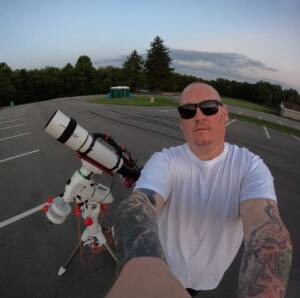
Discovery of the M31 [OIII] emission arc
Recently, a major discovery by an international team of amateur astronomers and scientists has become a huge online hit, and this new discovery is just located in one of the

First of all I want to thank you for this recognition. My name is Andrea vanoni, I’m 32 years old, I live in Porto Mantovano in Mantua, Italy. I work as a professional worker whit disabled people. I’ve always been fun of astronomy, in 2007 I started practicing astrophotography with a Celestron CPC800 (Schmidt-Cassgrain telescope) with this I fell in love with the Moon and the Planets of our solar system. I’m a communicator in astronomy with the aim of bringing astronomy to everyone.

For me astronomy is a way to open the mind, to discover new worlds, to see beyond our planet. Astronomy is a way to see our uniqueness but it’s also a way too see how fragile we’re in the huge universe, and this remind us to always preserve our unique home.
I currently use this gears:
– Newton “ARES” 405mm in diameter F4.5 which I have personally restored.
– 305mm F5 “DEIMOS” Newtonian
– Achromatic refractor 152/900 and Daystar Quark Chromosphere for solar recovery


I find that our neighbors: the moon, the sun and the planets, are unmistakably charming because everyday them show themselves differently: the sun with his rapidly changing solar activity, the moon with thousand of craters, rimae, domes and Sea that we can film, the planets as mars and his sandstorms, Jupiter with his hurricanes, venus and his clouds filmable in Uv light. Well, it’s a world alive, right next to us. Unfortunately, the deepsky don’t excite me as much.

The night of the 20th April 2021 has been a really magical night, I filmed almost 1 terabyte of different video about the moon. In particular, in the rupes recta zone I managed to push the resolution by using a Baader G filter. In this way, thanks with excellent seeing of the day, I obtained high quality details. The rupes recta is definitely a suggestive zone. This slits over 300km long is incredible to observed and film with the telescope. Big diameter can offer a breathtaking view thanks to the many craters. I filmed with “Ares” the main telescope of 405mm, Skywatcher EQ8, Barlow APM 2.7x and ASI178MM that thanks to the wide angle format has allowed me to shot an extremely wide area.

Surely, the capture and elaboration phase. The acquisition phase is important because you need to properly balance the histogram, especially with the moon to avoid losing the parts very bright. In this case, the excellent dynamic range of ZWO cameras help. The elaboration phase is crucial to extract the details from the raw without exaggerate and keeping it as close to natural as possible, to preserve image from artifacts.

light pollution is an evil that especially afflicts my nation, Italy. There are many associations that fight light pollution, trying to sensitize cities and municipalities to the use of public lighting that is correctly directed and through the use of correct lamps. Unfortunately, very often the interests are greater than the protection of the environment. If the situation does not improve, it will be necessary to always go to the mountains or use increasingly selective filters.

I divulge with my Astronomical group called “Astroavventura” which was born in 2018. With it have done many live-streaming in pandemic period to allow everyone to discover and approach the astronomy world. I’m interested in contrinuting to amateur scientific research by constantly mapping our solar system.


I have ZWO AS174 and ZWO ASI178. My favorite camera is ASI174 because it have a large pixel size and I can use it for auto-guide and shot some deepsky object when there are not planets.

In the second half of the year I think I will focus on the recovery of the giants Jupiter and Saturn, even if from my area they are still too low on the horizon. I also plan to shoot a very large, high-resolution mosaic of the moon.

In my opinion ZWO should continue this way. It is a company that has been able to allow many people to obtain spectacular images of the moon, planets, sun, galaxies, nebulae and much more at a competitive price. I started with an ASI120MM in 2015. Since then I have always been satisfied.



Recently, a major discovery by an international team of amateur astronomers and scientists has become a huge online hit, and this new discovery is just located in one of the

That 11-year-old boy staring at Horsehead Nebula photo would never have imagined… Decades later, he’d be capturing amazing deep-sky images from his Florida backyard! “ It was amazing to see

Hello,Sara Harvey,thanks for accepting our interview invitation. Congratulations on winning the ASIWEEK competition in week! Q1: At first, congratulation that your nice image won #ASIWEEK. Can you introduce yourself to

Astrophotography is more than just capturing images of the night sky—it’s a journey of discovery, patience, and creativity. For this passionate astrophotographer, what started as a chance encounter with a

Taranjot Singh, an Indian origin Australian astrophotographer who is making waves on the international stage. Taranjot has been recognized as one of the Top 5 finalists in the prestigious Siena

The back focal length is advised by telescope manufacturers. Since most telescopes have a 55mm back focal length, we are here to provide detailed instructions for all ASI cooled cameras.Please
1 Comment
Marco Scardovelli
Bellissima intervista…